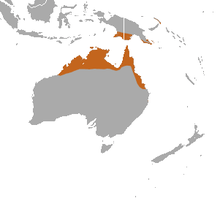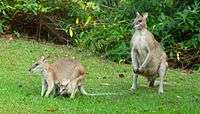Agile wallaby
| Agile wallaby[1] | |
|---|---|
 | |
| Scientific classification | |
| Kingdom: | Animalia |
| Phylum: | Chordata |
| Class: | Mammalia |
| Infraclass: | Marsupialia |
| Order: | Diprotodontia |
| Family: | Macropodidae |
| Genus: | Macropus |
| Species: | M. agilis |
| Binomial name | |
| Macropus agilis (Gould, 1842) A | |
 | |
| Agile wallaby range | |
The agile wallaby (Macropus agilis) also known as the sandy wallaby, is a species of wallaby found in northern Australia and New Guinea. It is the most common wallaby in Australia's north. The agile wallaby is a sandy colour becoming paler below. It is sometimes solitary and at other times sociable and grazes on grasses and other plants. The agile wallaby is not considered threatened.
Subspecies
There are four subspecies of the agile wallaby:
- M. a. agilis – the nominate subspecies is found in Northern Territory;
- M. a. jardinii – this subspecies is found on the northern and eastern coasts of Queensland;
- M. a. nigrescens – found in the Kimberley and Arnhem Land regions of Western Australia;
- M. a. papuanus – found in southern and southeastern Papua New Guinea and some neighbouring islands.[3]
Description

Male agile wallabies are considerably larger than females, having a head and body length of up to 85 cm (33 in) and weighing 16 to 27 kg (35 to 60 lb) while the females grow to 72 cm (28 in) in length and weigh 9 to 15 kg (20 to 33 lb). The tails of both genders are long and flexible, giving a total length of double the head and body length. They have relatively large ears, which are edged with black, and the tip of the tail is also black. Their backs are sandy brown while their underparts are whitish. They have a dark stripe between the ears, a pale cheek stripe on each side of the face and another pale streak across the thighs.[4][5]
Distribution and habitat
The agile wallaby is found in northern Australia, Papua New Guinea and the Indonesian province of Papua. It is the most common wallaby over much of the north of Australia.[6] In northern Australia and down the eastern coast of Queensland it is quite common, and there are isolated populations in southeastern Queensland around Coomera, Jacobs Well and Hope Island. It is also present, though not common, on Stradbroke Island and on Woogoompah Island in the Southern Moreton Bay Islands, and it may still be present on Peel Island. In Australia its typical habitats are dry open woodland, heaths, dunes and grassland.[7] It is often present in the vicinity of rivers and bilabongs. When grass is in short supply, it sometimes browses on shrubs or moves onto agricultural land, including sugar cane plantations.[4]
Behaviour
In general the agile wallaby is a solitary animal, but it sometimes forms into groups when feeding on open pastures, a behaviour that may help with predator awareness. The agile wallaby feeds mainly at night on grasses, legumes and other herbaceous plants, but may also forage by day, especially in the wet season. In the dry season the animal's range grows larger as the quality of the grazing deteriorates and the diet expands to include flowers, fruit, twigs, fallen leaves, roots and bark.[5] In the dry season in Boodjamulla National Park in Queensland, when food is in short supply, it has been observed pulling up seedling Livistona palms with its teeth, eating the roots and stems and discarding the leaves. When they are available, it eats the fruits of these palms, but in the dry season it also crushes and eats the hard seeds. It also consumes other seeds that have passed through the guts of fruit-eating birds.[4] It sometimes digs holes in dry creeks and bilabongs to search for water, and this is thought to help it avoid being killed by the saltwater crocodile (Crocodylus porosus) that can be found beside rivers.[4]
Breeding takes place at any time of year, with the female becoming receptive soon after giving birth. Male behaviour includes "play-fighting", leaping into the air and sinuously lashing the tail. After a brief courtship, mating takes place after which there is an embryonic diapause in which the embryo remains in a state of dormancy before implanting. The gestation period is about thirty days after which the young wallaby is born and makes its way to its mother's pouch. It remains there for seven to eight months and is weaned at about eleven months.[4][5]
Status
The agile wallaby has a wide range and is common over much of that range. It faces no major threats, however in New Guinea it is shot for bushmeat and in Australia it is sometimes killed by farmers as a pest. It is present in a number of protected areas in Australia but this is not the case in New Guinea. Overall, the population is thought to be declining, but the total population is large and the rate of decline is slow so the IUCN considers this wallaby to be of "least concern".[2]
References
- ↑ Groves, C.P. (2005). Wilson, D.E.; Reeder, D.M., eds. Mammal Species of the World: A Taxonomic and Geographic Reference (3rd ed.). Baltimore: Johns Hopkins University Press. p. 63. OCLC 62265494. ISBN 0-801-88221-4.
- 1 2 Aplin, K.; Dickman, C.; Salas, L.; Woinarski, J. & Winter, J. (2008). "Macropus agilis". IUCN Red List of Threatened Species. Version 2008. International Union for Conservation of Nature. Retrieved 28 December 2008.
- ↑ Merchant, J.C. (1983). Ronald Strahan, ed. Agile Wallaby in The Complete Book of Australian Mammals. Angus & Robertson. p. 242.
- 1 2 3 4 5 Richardson, Ken (2012). Australia's Amazing Kangaroos: Their Conservation, Unique Biology and Coexistence with Humans. Csiro Publishing. pp. 60–61. ISBN 978-0-643-10715-1.
- 1 2 3 "Agile wallaby". The kangaroo trail. Rootourism. 2008-04-01. Retrieved 2014-08-01.
- ↑ Menkhorst, Peter (2001). A Field Guide to the Mammals of Australia. Oxford University Press. p. 110.
- ↑ "Agile wallaby". Queensland Museum. Retrieved 2014-08-01.
External links
| Wikimedia Commons has media related to Macropus agilis. |
| Wikispecies has information related to: Macropus agilis |
